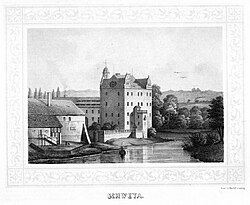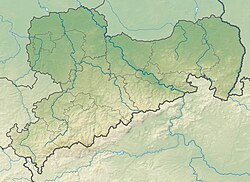Schweta Castle
| Schweta Castle | ||
|---|---|---|
 Schweta Castle around 1850 |
||
| Data | ||
| place | Schweta at Chub | |
| Architectural style | Renaissance | |
| Construction year | circa 1600 | |
| demolition | 1953 | |
| Coordinates | 51 ° 7 '42.5 " N , 13 ° 3' 9.1" E | |
|
|
||
The Schweta Castle was an original water castle that in 1600 in a castle in Renaissance style was rebuilt. It stood in Schweta , today a district of Döbeln , in the district of central Saxony in Saxony . In 1953 it was blown up.
history
The castle was located at the confluence of the Zschopau and Freiberger Mulde rivers . At the place where the castle rose, there must have been a Slavic rampart, as urn finds and the name Schweta, Slavic swjet (holy), indicate this. The mountain ledge was probably conveniently located and at the same time a pagan place of sacrifice and seat of a supan. According to a legend , a castle was built in Schweta in the 9th century where a bishop had his seat, which is why a mountain opposite the former castle is called "Bischofsberg" and a meadow is called "Bischofswiese".
Noble owners
In earlier times only nobles were entitled to a fiefdom . Therefore, only nobles had manors , castles and palaces .
Schweta family
In 1288 the manor was first mentioned in a document . The first known owner was Otto von Sueth, who was named when Albrecht II , Landgrave of Thuringia , enfeoffed the Buch monastery in Rochlitz . The same Otto von Sueth was named with a Conrad von Sueth in a document from 1290, when the Landgrave of Thuringia owned the Buch monastery with the village of Erlau . It can therefore be assumed that Schweta Castle was the ancestral seat of the Lords of Schweta, who named themselves after their castle according to the custom of the early Middle Ages .
Von Maltitz family
At the beginning of the 14th century, the castle belonged to another family. In 1328 the brothers Friedrich, Hermann and Albrecht von Maltitz were named as owners , because they donated some of their income from the villages of Marschitz and Albertitz to the Staucha monastery , which the Landgrave of Thuringia, Friedrich II. , Confirmed on St. Vitus Day . In 1485 the Burgraves of Meißen claimed the Margrave's claim to the then saddle yard . Schweta
Von Honsberg family
The castle passed from the von Maltitz family to the von Honsberg family . According to a Freiberg charter from 1454, Tylich von Honsberg, Knight of Schweta, owned Schweta Castle. Dietrich von Honsberg received the feud over Schweta in 1461 and in 1483 Georg von Honsberg received the village of Rossau with courts, interest, church loan, village, the Vorwerk Limmritz and the village of Technitz in lehen from the Leisniger burgrave . Schweta himself was a margrave fief at that time . 1512 followed Hans von Honberg, 1537 Hans Dietrich von Honsberg. In 1551 Schweta became a manor and in 1555 Georg von Honsberg was the owner. He was master of Rossau and the large forest that went with it. Johann von Honsberg sold this forest to Elector Friedrich III in 1569 . In 1576 Eustachius von Honsberg owned Schweta. In 1582 the daughter of Hans von Honsberg II, Margaretha, married Hans Georg von Schönberg (1549–1618) on Schönau. This Hans von Honsberg II was the last Honsberg owner of the castle. In the more than 130 years in the possession of the von Honsberg family, the castle has been rebuilt several times.
Wallwitz family
Melchior von Hayn was the owner of the fief in 1592 and it came from him to Adam von Wallwitz around 1604 , who had the castle converted into a palace around this time.
Von Schönberg family
In 1630 Caspar von Schönberg owned the castle and in 1671 Caspar Heinrich von Schönberg, who left it to his son, Caspar Joachim von Schönberg, in the same year. The von Schönberg family continued to own Schweta into the 18th century.
Von Metzsch family
In 1728 Friedrich Gottlob von Metzsch was master of Schweta Castle and in 1735 he left the castle to his son, Ernst Friedrich Gottlob von Metzsch. On March 17, 1765, a fire broke out in the manor's farm building. The shepherd who slept in it was barely able to save himself, but the building, all the cattle and the grain were burned. Later the castle belonged to the royal Prussian colonel and holder of the order Pour le Mérite , Johann Ernst Siegmund von Metzsch (* January 23, 1739 - May 10, 1812) and his brother Hans Gottlob Friedrich von Metzsch. This family was the last noble family from Schweta Castle.
Bourgeois owners
At the end of the 17th century, commoners were also allowed to purchase a manor, and their number rose sharply in the middle of the 18th century. The sole rule of the nobility was over.
The Hensel family
In 1840 the Dresden merchant Albert Barchwitz acquired the castle from Wilhelm Heinrich von Metzsch and sold it to Heinrich Hensel as early as 1845: In 1847, he had Friedrich Gruhl cast a bell for the castle tower in Kleinwelka . At that time, 161 hectares and a spirit and pressed yeast factory belonged to the manor .
Other owners
The families Hermann, Cordes and Möhring were also owners of the castle.
Destruction of the castle
After the end of the Second World War , the castle was looted and on October 3, 1945 the lands of the manor, about 160 hectares, were distributed to 25 new farmers and more than 40 small settlers as land reform land . With the SMAD order no. 209 it was finally blown up and continued to be used as building material. The sandstone chimney and the castle bell can now be seen in the museum at Mildenstein Castle in Leisnig .
Web links
swell
- Gustav Adolf Pönicke: Album of the manors and castles in the kingdom of Saxony. Section 2, Meissner Kreis, Gustav Adolf Pönicke, Leipzig 1854–1861, pp. 12, 13, 14
Individual evidence
- ↑ Emil Reinhold, Geschichtliches Heimatbuch des Bezirk Döbeln , Adolph Thallwitz Döbeln 1925, page 29
- ↑ Valentin Ritter von Streffleur, Austrian Military Journal. , Vol. 3, Verlag der Redaction, Singerstrasse 16, Vienna 1868, page 298
- ↑ a b c Karlheinz Blaschke , Susanne Baudisch, Historical Directory of Saxony , Half Volume 2 N – Z, Universitätsverlag GmbH Leipzig 2006, page 693, ISBN 3-937209-15-8
- ^ Emil Reinhold, Geschichtliches Heimatbuch des Bezirk Döbeln , Adolph Thallwitz Döbeln 1925, page 33
- ^ Carl Samuel Hoffmann, Historical Description of the City, the Office and the Dioces of Oschatz in Older and Modern Times. , Part 2, Friedrich Christian Ludwig Oldecop Oschatz 1817, page 190
- ^ Carl W. Hingst , Chronicle of Döbeln and the surrounding area , Carl Schmidt, Döbeln 1872, p. 78 ( online ).
- ↑ Statutes and list of members of the history and antiquity research association for Leisnig and the surrounding area. , Herrmann Ulrich Leisnig 1867, page 14
- ^ Heinz Pannach, The Office of Meissen from the beginning of the 14th to the middle of the 16th century: Studies on social structure, constitution and administration , Vol. 71, Akademie Verlag , Berlin 1960, page 97, ISSN 0071-7673
- ^ Carl Samuel Hoffmann, Historical Description of the City, the Office and the Dioces of Oschatz in Older and Modern Times. , Part 2, Friedrich Christian Ludwig Oldecop Oschatz 1817, page 191
- ^ Albert Fraustadt , History of the Schoenberg family Meissnischen tribe , Vol. 1, Giesecke & Devrient Leipzig 1869, page 159
- ↑ Carl W. Hingst, Chronicle of Döbeln and the surrounding area , Carl Schmidt Döbeln 1872, page 179
- ↑ Leopold Freiherr von Ledebur , Adelslexikon der Prussischen Monarchy . , Vol. 2, Ludwig Rauh Berlin 1854, page 99
- ^ Max Grimmer, Chronicle of Leisnig 1700–1954 , Leisniger Geschichts- und Heimatverein Leisnig 2003, page 17, ISBN 3-00-012023-8
- ^ Archives for kin research and all related areas , Vol. 51, Issue 97, CA Starke 1985, page 258
- ^ Carl W. Hingst, Chronicle of Döbeln and the surrounding area , Carl Schmidt Döbeln 1872, page 291
- ↑ Official report on the assembly of German farmers and foresters in Dresden, from June 25 to July 1, 1865. , G. Schönfeld's Buchhandlung Dresden 1866, page 37
- ^ Markus A. Denzel , German nobility in the 19th and 20th centuries: Büdinger research on social history 2002 and 2003 , Scripta Mercaturae, St. Katharinen 2004, page 214, ISBN 978-3-89590-145-4
- ↑ Address book of merchants, manufacturers and tradespeople of the Kingdom of Saxony and the duchies and principalities of Saxony-Altenburg, Weimar-Eisenach, Koburg-Gotha, Meiningen, Reuss, Schwarzenburg, Schleusingen, Schmalkalden, Suhl. , CL Leuchs & Co. Nuremberg 1870, pages 107, 108
- ^ Friedrich Adolf Peuckert, The ger. and fully St. Johannisloge to the three swords and Asträa to the green diamond in the Orient Dresden 1738–1882: A contribution to the history of Freemasonry in Dresden and Saxony. Edited from archival sources , Bruno Zechel Leipzig 1883, page 276
- ^ German Agricultural Society , Yearbook of the German Agricultural Society , Vol. 3, Paul Parey Berlin 1889, page 55
- ^ City Council Assembly and Council of the City of Döbeln, Döbeln from past and present , Typodruck-Schaubeck Leipzig 1981, page 67





